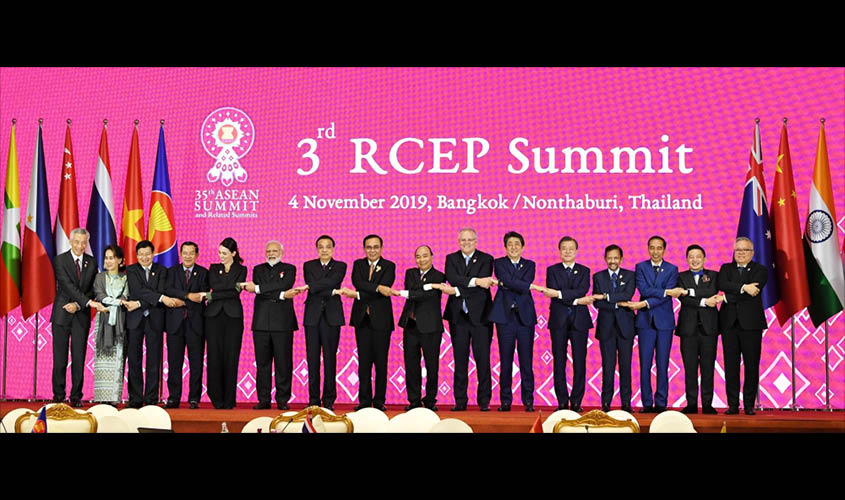NEW DELHI :The possible damage that could have been inflicted on the country’s ailing Small and Medium-Sized Enterprises (SMEs) and agriculture sectors recently made Prime Minister Narendra Modi opt out of signing the Regional Comprehensive Economic Partnership (RCEP) deal aimed at creating a free trade economic zone. Both the agriculture and SMEs sectors lack the ability to compete with other Asian or South-East Asian countries and the signing of such deal in this given situation would not have been a smart step, a top expert has said.
The RCEP deal was under deliberation since 2012. Given the scale, the RCEP would not have been an ordinary deal and thus India’s decision to opt out received wide welcome from many sections including the Opposition parties, farmers’ organisations like the All India Kisan Sangharsh Samiti (AIKSCC), Indian Coordination Committee of Farmers’ Movement (ICCFM) and the RSS-backed Swadeshi Jagaran Manch and trade bodies, besides others.
According to an expert, India’s decision not to sign the RCEP deal for the time being is a smart step and the credit goes to Prime Minister Narendra Modi. His step would protect the country’s ailing SMEs.
Rajiv Chawla, chairman, IamSME of India, told The Sunday Guardian: “Unfortunately, in the last four-five years, India’s SMEs’ sector is under a lot of pressure. First, this sector was hammered due to demonetisation that weakened the sector; then, the imposition of the Goods and Services Tax (GST), that too without any preparedness, affected the sector. Adding to this, the same year when the GST was implemented, the government also stopped all subsidies that were available to this sector. All these decisions together killed the competitiveness of SMEs. Now, in such a scenario, signing a comprehensive deal like the RCEP would have been a foolish idea.”
“Interestingly, soon after demonetisation, the crisis in the banking and NBFC sectors started which led to a crisis in credit inflow for the SMEs. The situation was aggravated by increased regulatory compliances like environment and corporate compliances which entirely damaged the country’s SMEs’ sector. The apathy of the government towards the SMEs’ sector can be understood from the fact that five years ago, the government had promised to bring in a new definition for the SMEs’ sector, but that has not happened yet,” Chawla said.
“In my view, India’s opting out of signing the RCEP is a short term measure and a temporary relief to the SMEs’ sector. Looking at the present level of preparedness and competitiveness of the SMEs, India can’t compete with Thailand’s or China’s SMEs; so Indian SMEs need more preparation time to join such a free trade zone,” Chawla said.
“The Make-in-India is a scheme that invites foreign manufacturers in the country. The government has reduced the corporate tax and given incentives to attract foreign direct investment (FDI) and these are encouraging steps to attract foreign manufacturers. While earlier, only the large MNCs like Hyundai, General Motors and Ford would come to India, now even smaller companies from China, Taiwan, Korea, and Thailand are coming to India and setting up tier-II industries and beating Indian SMEs in their own backyard. Thus, as a long term measure, the government must think about how to improve the competitiveness of Indian SMEs,” Chawla added.
The RCEP negotiations were launched by ASEAN leaders and the six other countries during the 21st ASEAN Summit in Phnom Penh in November 2012. The aim of initiating the RCEP talks was to achieve a comprehensive, high-quality, and mutually beneficial economic zone among the ASEAN member states and their partners.
India’s past experience of free trade agreements has not been good as it has witnessed losses in rubber, coffee, coconut, cardamom, and pepper farming due to similar agreements.
As per Chawla, it is not the case that India would not have gained from the deal. There are many sectors including education, information technology, health and the pharmaceutical industry which could have been “front runners” if the deal had been signed, he said.
If the deal had been signed, the RCEP would have become the world’s largest FTA, comprising half of the world’s population which accounts for nearly 40% of the world’s trade and 39% of the world’s GDP ($49.5 trillion). This could be the largest regional trade agreement in the world involving 16 countries—Association of Southeast Asian Nations (Brunei, Cambodia, Indonesia, Laos, Malaysia, Myanmar, the Philippines, Singapore, Thailand, and Vietnam) and their five FTA partners (Australia, China, Japan, New Zealand, and South Korea). India, ASEAN’s sixth FTA partner, has opted out of the agreement for now. The final deal will be signed in 2020.

